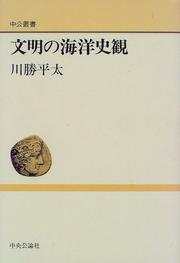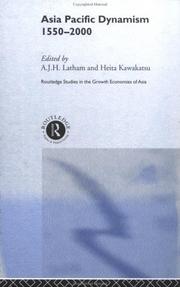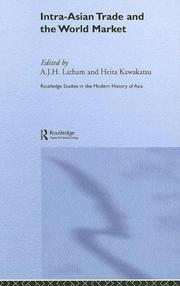| Listing 1 - 10 of 13 | << page >> |
Sort by
|

ISBN: 4120027155 9784120027154 Year: 1997 Publisher: Tōkyō : Chūō Kōronsha,
Abstract | Keywords | Export | Availability | Bookmark
 Loading...
Loading...Choose an application
- Reference Manager
- EndNote
- RefWorks (Direct export to RefWorks)
Ocean --- Ocean. --- Oceanography. --- Rekishi. --- Seafaring life. --- Folklore.
Article
Abstract | Keywords | Export | Availability | Bookmark
 Loading...
Loading...Choose an application
- Reference Manager
- EndNote
- RefWorks (Direct export to RefWorks)

ISBN: 041522778X 1138963941 0203465806 1280056487 0203248171 1134587201 9780203248171 9780203465806 9780415227780 9786610056484 661005648X 9781134587209 9781280056482 Year: 2000 Publisher: London ; New York : Routledge,
Abstract | Keywords | Export | Availability | Bookmark
 Loading...
Loading...Choose an application
- Reference Manager
- EndNote
- RefWorks (Direct export to RefWorks)
This volume showcases the latest research by a team of international scholars into the economic development of the Asia Pacific region.
Economic history. --- Asia --- Pacific Area --- Economic conditions --- History, Economic --- Asian and Pacific Council countries --- Economics --- Eastern Hemisphere --- Eurasia

ISBN: 0700716327 0700716319 Year: 2002 Publisher: London RoutledgeCurzon
Abstract | Keywords | Export | Availability | Bookmark
 Loading...
Loading...Choose an application
- Reference Manager
- EndNote
- RefWorks (Direct export to RefWorks)
Although 'Seibutsu no Sekai (The World of Living Things)', the seminal 1941 work of Kinji Imanishi, had an enormous impact in Japan, both on scholars and on the general public, very little is known about it in the English-speaking world. This book makes the complete text available in English for the first time and provides an extensive introduction and notes to set the work in context. Imanishi's work, based on a very wide knowledge of science and the natural world, puts forward a distinctive view of nature and how it should be studied. Imanishi's work is particularly important as a background to ecology, primatology and human social evolution theory in Japan.

ISBN: 1280480742 9786610480746 0203086503 0415372070 0415546923 Year: 2017 Publisher: Abingdon, Oxon : Routledge,
Abstract | Keywords | Export | Availability | Bookmark
 Loading...
Loading...Choose an application
- Reference Manager
- EndNote
- RefWorks (Direct export to RefWorks)
Intra-Asian trade is a major theme of recent writing on Asian economic history. From the second half of the nineteenth century, intra-Asian trade flows linked Asia into an integrated economic system, with reciprocal benefits for all participants. But although this was a network from which all gained, there was also considerable inter-Asian competition between Asian producers for these Asian markets, and those of the wider world.This collection presents captivating snap-shots of trade in specific commodities, alongside chapters comprehensively covering the region. The book covers: Chi
Asia --- Foreign economic relations. --- Commerce. --- Regional studies --- Asian history --- Ethnic studies --- Economic history --- hong --- kong --- tan --- kim --- ching --- chinese --- merchants --- raw --- silk --- dutch
Book
Abstract | Keywords | Export | Availability | Bookmark
 Loading...
Loading...Choose an application
- Reference Manager
- EndNote
- RefWorks (Direct export to RefWorks)
Intra-Asian trade is a major theme of recent writing on Asian economic history. From the second half of the nineteenth century, intra-Asian trade flows linked Asia into an integrated economic system, with reciprocal benefits for all participants. But although this was a network from which all gained, there was also considerable inter-Asian competition between Asian producers for these Asian markets, and those of the wider world. This collection presents captivating snap-shots of trade in specific commodities, alongside chapters comprehensively covering the region. The book covers: China's relative backwardness, Japanese copper exports, Japan's fur trade, Siam's luxury rice trade, Korea, Japanese shipbuilding, the silk trade, the refined sugar trade, competition in the rice trade, the Japanese cotton textile trade to Africa, multilateral settlements in Asia, the cotton textile trade to Britain, and the growth of the palm oil industry in Malaysia and Indonesia. The opening of Asia, especially in Japan and China, liberated the creative forces of the market within the new intra-Asian economy. Filling a particular gap in the literature on intra-Asian trade prior to the twentieth century, this is an insightful study that makes a considerable contribution to our knowledge of the Asian trade both prior to, and after, the arrival of colonial states. It will be of great interest to historians and economists focusing on Asia.
Book
Abstract | Keywords | Export | Availability | Bookmark
 Loading...
Loading...Choose an application
- Reference Manager
- EndNote
- RefWorks (Direct export to RefWorks)
Intra-Asian trade is a major theme of recent writing on Asian economic history. From the second half of the nineteenth century, intra-Asian trade flows linked Asia into an integrated economic system, with reciprocal benefits for all participants. But although this was a network from which all gained, there was also considerable inter-Asian competition between Asian producers for these Asian markets, and those of the wider world. This collection presents captivating snap-shots of trade in specific commodities, alongside chapters comprehensively covering the region. The book covers: China's relative backwardness, Japanese copper exports, Japan's fur trade, Siam's luxury rice trade, Korea, Japanese shipbuilding, the silk trade, the refined sugar trade, competition in the rice trade, the Japanese cotton textile trade to Africa, multilateral settlements in Asia, the cotton textile trade to Britain, and the growth of the palm oil industry in Malaysia and Indonesia. The opening of Asia, especially in Japan and China, liberated the creative forces of the market within the new intra-Asian economy. Filling a particular gap in the literature on intra-Asian trade prior to the twentieth century, this is an insightful study that makes a considerable contribution to our knowledge of the Asian trade both prior to, and after, the arrival of colonial states. It will be of great interest to historians and economists focusing on Asia.
Book
ISBN: 9780415600323 Year: 2011 Publisher: London Routledge
Abstract | Keywords | Export | Availability | Bookmark
 Loading...
Loading...Choose an application
- Reference Manager
- EndNote
- RefWorks (Direct export to RefWorks)
Book
ISBN: 1315098547 1351580426 Year: 2018 Publisher: London : Taylor and Francis,
Abstract | Keywords | Export | Availability | Bookmark
 Loading...
Loading...Choose an application
- Reference Manager
- EndNote
- RefWorks (Direct export to RefWorks)
"This collection of essays sheds new light on many aspects of Asias integration with the international economy. H.I.H. Crown Prince Naruhito discusses the problems of controlling water in the interest of urban development. He first examines the problems encountered on the River Thames in relationship to the growth of London in the eighteenth century, and then relates his findings to Japan where similar problems arose with respect to the expansion of Edo (Tokyo). Other chapters looking at the eighteenth century examine the development of plant collecting in Asia and the wider world in the interest of the economy and leisure, Japans connections with the outside world by way of the Dutch East India Company (VOC), and the Dutch acquisition of the knowledge of the Japanese language at their base at Dejima Island, Nagasaki. India features next with achapter showing how India was crucial in initiating the industrial revolution in Britain, by stimulating British manufacturers to copy the fine textiles made by hand loom weavers there. This is followed by a chapter showing how in the late nineteenth century India was the central pivot in the entire international economic system, based on its trading surplus with China. Otherdiscussions trace the role of Scotland as a centre of heavy industry and shipbuilding, with Scottish companies dominating the shipping lanes of Asia. A furtherchapter shows how British connections with Asia, in this case Shanghai, brought problems of debt and non payment, and outlines the steps taken to try to control the situation. Elsewhere problems arose in Bangkok over the quality of rice being supplied to European merchants in the 1920s, leading to a decline in sales. Finally there is a discussion of Japanese commercial policy towards Africa in the inter-war period. This book will be of interest and use to students, researchers, and general readers interested in Asias role in world economic development."--Provided by publisher.
Industrial revolution --- History. --- Asia --- Economic conditions

ISBN: 0415115019 Year: 1994 Publisher: London Routledge
Abstract | Keywords | Export | Availability | Bookmark
 Loading...
Loading...Choose an application
- Reference Manager
- EndNote
- RefWorks (Direct export to RefWorks)
Industrialization --- Industrialization --- History --- History --- East Asia --- East Asia --- East Asia --- Japan --- Commerce --- History --- Commerce --- History --- Economic conditions --- Commerce --- History
| Listing 1 - 10 of 13 | << page >> |
Sort by
|

 Search
Search Feedback
Feedback About UniCat
About UniCat  Help
Help News
News